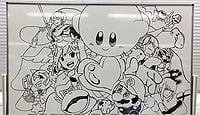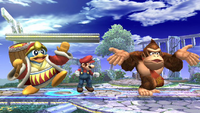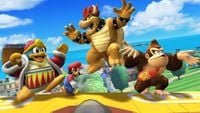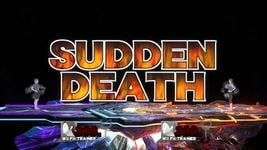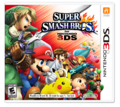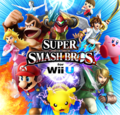Super Smash Bros. 4: Difference between revisions
No edit summary |
(Undid edit by Cinos121: that's not how lead paragraphs work in a wiki article) |
||
| Line 21: | Line 21: | ||
| input = | | input = | ||
}} | }} | ||
'''''Super Smash Bros. 4''''' (also referred to by shorthands such as '''''Smash 4''''', '''''SSB4''''', or more informally '''''Sm4sh''''', and officially as '''''Super Smash Bros. for Nintendo 3DS/Wii U''''') is a term used to collectively refer to '''{{For3ds}}''' and '''{{Forwiiu}}''', two games in the ''{{b|Super Smash Bros.|series}}'' series created by [[Namco Bandai]]<ref name="ign-namco">[http://www.ign.com/articles/2012/06/22/namco-bandai-developing-next-smash-bros IGN: "Namco Bandai Developing Next Smash Bros."]</ref> and [[Sora Ltd.]] The games feature mostly identical gameplay, but with several differences in other areas. The 3DS version is the first game of the series to be released on a handheld. | '''''Super Smash Bros. 4''''' (also referred to by shorthands such as '''''Smash 4''''', '''''SSB4''''', or more informally '''''Sm4sh''''', and officially as '''''Super Smash Bros. for Nintendo 3DS/Wii U''''') is a term used to collectively refer to '''{{For3ds}}''' and '''{{Forwiiu}}''', two games in the ''{{b|Super Smash Bros.|series}}'' series created by [[Namco Bandai]]<ref name="ign-namco">[http://www.ign.com/articles/2012/06/22/namco-bandai-developing-next-smash-bros IGN: "Namco Bandai Developing Next Smash Bros."]</ref> and [[Sora Ltd.]] The games feature mostly identical gameplay, but with several differences in other areas. The 3DS version is the first game of the series to be released on a handheld. | ||
Revision as of 17:34, March 24, 2015
| Super Smash Bros. 4 (unofficial title) | |
|---|---|
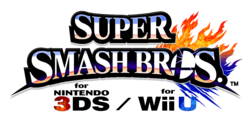 Collective logo for the game. | |
| Developer(s) | Bandai Namco Sora Ltd. |
| Publisher(s) | Nintendo |
| Designer(s) | Masahiro Sakurai |
| Released | Nintendo 3DS September 13, 2014 October 2, 2014 October 3, 2014 October 4, 2014 (unreleased) 2015 Wii U November 21, 2014 November 28, 2014 November 29, 2014 December 6, 2014 |
| Genre(s) | Fighting |
| Mode(s) | Single player, Multiplayer, Online multiplayer |
| Ratings | CERO: A ESRB: E10+[1] OFLC: PG (3DS)[2] PEGI: 12+ (provisional) |
Super Smash Bros. 4 (also referred to by shorthands such as Smash 4, SSB4, or more informally Sm4sh, and officially as Super Smash Bros. for Nintendo 3DS/Wii U) is a term used to collectively refer to Super Smash Bros. for Nintendo 3DS and Super Smash Bros. for Wii U, two games in the Super Smash Bros. series created by Namco Bandai[3] and Sora Ltd. The games feature mostly identical gameplay, but with several differences in other areas. The 3DS version is the first game of the series to be released on a handheld.
When originally announced in passing at E3 2011, the game's development was slated to begin sometime after October 2011, once development on Kid Icarus: Uprising had been completed.[4] In February 2012, it was then confirmed that development on the fourth game had begun.[5] The game was unmentioned during E3 2012, something which many fans were disappointed about despite the known extremely early state of the game; the "first step of the process" was taken shortly after in mid-June. Masahiro Sakurai expressed disappointment that fans would be waiting for longer than expected for the game to be released due to the earliness of the initial announcement.[6] Shortly afterward, it was revealed during a Nintendo Direct that Namco Bandai was the primary developer alongside Sora Ltd., and had already completed a working prototype.[3]
The paired versions of the game were officially revealed at E3 2013 in the form of a trailer on June 11, 2013.
The 3DS version launched in Japan on September 13, 2014 and in most other parts of the world on October 3, 2014. The 3DS version was released in stores one day earlier in Germany on October 2, 2014 to avoid coinciding with a national holiday, and was released one day later in Australia on October 4, 2014 because of time zone differences. The Wii U version was released in North America on November 21, 2014, and was released on November 28, 2014 in Europe, one day later in Australia, and on December 6, 2014 in Japan (coincidentally releasing on Nintendo president Satoru Iwata's 55th birthday).
Both versions have received positive reviews; critics have applauded the fine-tuning of existing Super Smash Bros. gameplay elements but criticized some issues with online play. Both versions have sold quickly, with the 3DS version selling over 6.19 million copies worldwide as of December 2014, and the Wii U version selling over 3.39 million copies during the same time period.
Pre-trailer information
Sakurai had stated, in response to a fan asking him about whether a "child Link" would appear in the game, that he had not at the time decided on who would appear in the game. However, he had also said that he "can't say that it's entirely out of the realm of possibility that some Capcom character could appear in the next Smash Bros."[7] Indeed, Capcom's Mega Man was ultimately confirmed as playable.
Sakurai had revealed that one feature of the 3DS Smash Bros. title would be that players can improve their character through battles and rewards, then transfer them to the Wii U Smash title to play against friends; such a function was made possible through character customization. He said the 3DS title was intended to offer a new experience for veteran Smash Bros. fans, and that neither the 3DS game nor the Wii U game would simply be sequels like Melee and Brawl were, and that they would do more than just add characters and stages. It had also been revealed that they were looking towards co-operative play for the Wii U title. Official Nintendo Magazine said "there is merit in having skilled and unskilled players play together, so one emphasis will be on elements of players helping one-another". They also stated that the graphics would be significantly stepped up, as the Wii U can handle high quality graphics, dynamic effects and smooth character movements in HD at 60 frames per second.[8] Sakurai was also quoted as claiming that the new game is unlikely to emphasize new playable characters, focusing instead on gameplay balance and distinctiveness of its characters. [9]
On July 2nd, 2012, Sakurai posted a whiteboard drawing on Twitter which was drawn by the game's staff. It depicts Donkey Kong, Fox, a Heart Container, Kirby, Link, Luigi, Mario, Marth, Meta Knight, Mr. Game & Watch, a Mr. Saturn, Pikachu, a Pikmin, Pit, Sandbag, Wario, and Zero Suit Samus; some argue that the curved lines in the background form the shape of Master Hand. While it came with no explicit confirmation of any of these characters or elements as reappearing, it did show they were in some sense acknowledged by the staff and everything depicted would turn out to appear in the final game anyway. The image itself was later removed from the original Twitter post.[10] The sketch also has what appears to be large block letters hidden below the visible area.
Characters
The original announcement of the game revealed a number of playable characters. Since then, other characters were announced via Miiverse, Nintendo Directs, and other videos until the official release of the game. There are 50 character slots on the roster (52 counting each Mii Fighter as an individual character). Twelve of them need to be unlocked before they appear in the 3DS version, and 8 are unlockable in the Wii U version. Only one character, Mewtwo, is confirmed to appear as downloadable content.
| Veterans (37) | |||||||||||||||
|---|---|---|---|---|---|---|---|---|---|---|---|---|---|---|---|
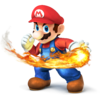 Mario |
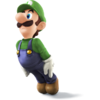 Luigi |
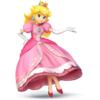 Peach |
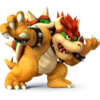 Bowser |
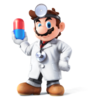 Dr. Mario |
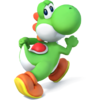 Yoshi |
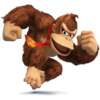 Donkey Kong |
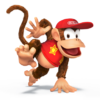 Diddy Kong | ||||||||
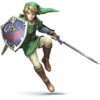 Link |
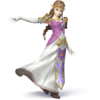 Zelda |
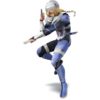 Sheik |
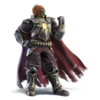 Ganondorf |
 Toon Link |
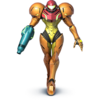 Samus |
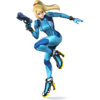 Zero Suit Samus |
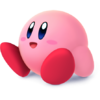 Kirby | ||||||||
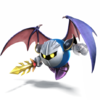 Meta Knight |
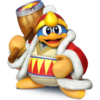 King Dedede |
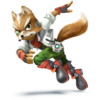 Fox |
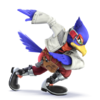 Falco |
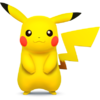 Pikachu |
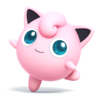 Jigglypuff |
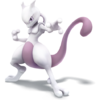 Mewtwo (DLC) |
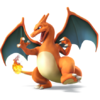 Charizard | ||||||||
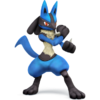 Lucario |
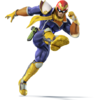 Captain Falcon |
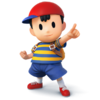 Ness |
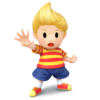 Lucas (DLC) |
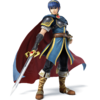 Marth |
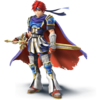 Roy (DLC) |
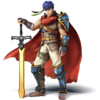 Ike |
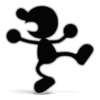 Mr. Game & Watch | ||||||||
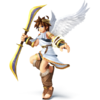 Pit |
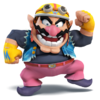 Wario |
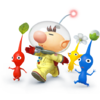 Olimar |
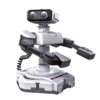 R.O.B. |
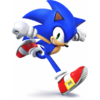 Sonic |
|||||||||||
| Newcomers (21) | |||||||||||||||
 Rosalina & Luma |
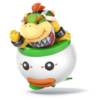 Bowser Jr. |
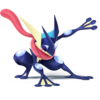 Greninja |
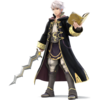 Robin |
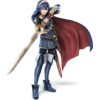 Lucina |
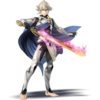 Corrin (DLC) |
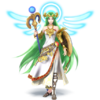 Palutena |
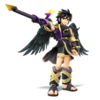 Dark Pit | ||||||||
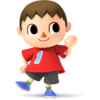 Villager |
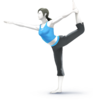 Wii Fit Trainer |
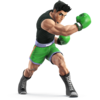 Little Mac |
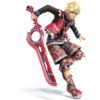 Shulk |
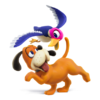 Duck Hunt |
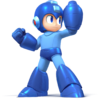 Mega Man |
 Pac-Man |
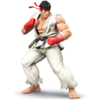 Ryu (DLC) | ||||||||
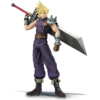 Cloud (DLC) |
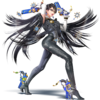 Bayonetta (DLC) |
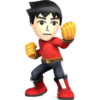 Mii Brawler |
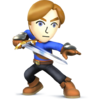 Mii Swordfighter |
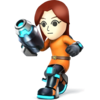 Mii Gunner |
|||||||||||
Bold denotes unlockable characters in both versions.
Bolded italics denote unlockable characters in the 3DS version only.
Stages
The two games feature considerably different stage selections, which is one of the biggest differences between the two games. The two versions share only 5 stages. The 3DS version features more stages based on handheld console games, while the Wii U version features more stages based on home console games. Several stages in both games, however, ignore this distinction.
In addition to new stages, several Past Stages, known now as "Familiar Stages", reappear in both versions of the game.
The 3DS version features a total of 34 stages with 7 unlockable, 25 of which are new and 9 are familiar ones. The Wii U version features a total of 46 stages with 6 unlockable, consisting of 29 new stages and 17 familiar ones. Additionally, a stage based on Miiverse is confirmed to appear in the Wii U version as part of a software update released after the game.
3DS version
Bold denotes unlockable stages.
Wii U version
Bold denotes unlockable stages.
Single-player modes
- Classic Mode
- All-Star Mode
- Home-Run Contest
- Trophy Rush
- Target Blast
- Multi-Man Mode
- Training Mode
- Event Mode (Wii U exclusive)
- Special Orders (Wii U exclusive)
- Movies (Wii U exclusive): This mode allows players to watch various movies and trailers pertaining to the game.
Shortly after the initial E3 2013 trailers, Sakurai said there would be a single-player story mode included in the new Smash Bros.[11], but that it would be different from Brawl's Subspace Emissary, and that there would be no cutscenes. However, he would later recant this, and announce that he decided to cut any sort of story mode altogether [12], while stating the 3DS version would have a different sort of separate mode from standard versus play. He did not provide any other details as to what this, or any other single-player modes will consist of. On 20 January 2014, on a Miiverse post, Sakurai repeated the fact the game would not have a story mode.[13] Screenshots that people thought were from a new story mode in the 3DS version were later revealed to be from Smash Run, which also seems to be the new 3DS mode Sakurai implied when he announced the cutting of the story mode.
Multi-player modes
- VS Mode
- 8-Player Smash (Wii U exclusive): In this mode, up to eight players can play in Smash battles.
- Smash Run (3DS exclusive): In this mode, up to 4 players have 5 minutes to traverse a huge dungeon-like environment, collecting various power-ups and facing many enemies from various games. After the time limit, the players go at it in a battle utilizing their boosted powers, and can then do subsequent matches with those power-ups. Sakurai mentioned in the Smash Bros. Direct video that this mode was inspired by Kirby Air Ride's City Trial mode, which has a similar premise.
- Players will also be able to have items set to their characters, in a way that may reflect Brawl's Subspace Emissary mode.
- Smash Tour (Wii U exclusive): Players take control of Miis moving along a game board, collecting characters and power-ups in order to win the final match, with each fighter collected acting as one stock.
Changes from Brawl
Gameplay changes
- The size differences between bigger and smaller characters is somewhat more drastic, which can be seen when comparing the pictures on the right, with Sakurai remarking "A group shot of the big guys. How much bigger are they compared to Mario?" for the latter image.[14]
- The movesets and animations of returning characters went through a larger amount of change than the returning characters did from the transition of Melee to Brawl, with many returning characters having completely new moves, and some moves being significantly altered (such as with Bowser).
- It additionally appears there is a greater emphasis on buffing the returning characters, with even characters that were top and high tier in Brawl, such as Diddy Kong and Lucario, being shown to receive explicit significant buffs. On the other hand, some characters who dominated Brawl or were buffed from Melee such as Meta Knight, Falco and Marth were nerfed to further balance the game.
- Mid-match character changes, such as Zelda/Sheik's Transform, no longer exist. This means Zelda and Sheik, along with Samus and Zero Suit Samus, are completely separate characters that are no longer able to transform to the other. This also means the Pokémon Trainer does not return as a playable character, though Charizard returns as its own stand-alone character. This is mainly due to a combination of 3DS hardware limitations and Sakurai's wish for both versions to contain the same roster of characters.[15]
- Random tripping introduced in Brawl has been removed. However, forced tripping remains, as shown by the return of the banana peel item.
- Similarly, it appears that potential randomness in moves was cut down; for example, Olimar now plucks his Pikmin in a set order instead of the Pikmin plucked being chosen at random, and King Dedede's Waddle Dee Throw has been replaced with a new move that involves throwing only Gordos instead of throwing one randomly chosen minion.
- However, Peach's down special is still random, with some turnips doing more damage than others, and there is no set order of which turnips are pulled from the ground; additionally, Mr. Game & Watch's Judge is now even more random, being able to get the same number twice in a row. Villager's up and down aerial moves also have a random element.
- Similarly, it appears that potential randomness in moves was cut down; for example, Olimar now plucks his Pikmin in a set order instead of the Pikmin plucked being chosen at random, and King Dedede's Waddle Dee Throw has been replaced with a new move that involves throwing only Gordos instead of throwing one randomly chosen minion.
- The game's speed is between that of Melee and Brawl, to appeal to both casual and hardcore gamers.
- In a similar appeal to both casual and hardcore gamers, there are now two distinct type of With Anyone Wi-Fi modes; one called For Fun, which seems similar to the previous game's casual-styled Basic Brawl, and one called For Glory, a mode explicitly catered to competitive-styled play.
- Additionally, every stage now has an Ω Form, where the stage's layout is altered into that of Final Destination. These forms cannot be played on in the For Fun mode, while they're the only forms available in the For Glory mode.
- The ability to act out of hitstun has been removed when sent large distances; however, at smaller launch distances, the amount of hitstun appears to be reduced, or character appear to be able to act out of hitstun. This, combined with higher base knockback in general, makes true combos more prevalent, but also more difficult to pull off.
- Neutral attacks that previously ended in an indefinite number of weak hits (such as Fox's and Kirby's) will now "always transition into a finishing move", making such moves safer to use (as simply ending the move no longer leaves the opponent nearby).[16] Rapid jabs can still be held indefinitely, but the user will be pushed back if they land too many hits on one opponent, making infinite combos against walls impossible.
- Holding the right control stick (C-Stick on GameCube controller) in a direction will now charge smash attacks until the stick is released.
- It appears that pummeling has been sped up dramatically.
- The mechanics of grabbing ledges underwent an unprecedented overhaul[17]. The difference between fast and slow edge options based on current damage has been removed, the length of intangibility given by grabbing the ledge is now affected by air time and current damage. Additionally, attempting to grab a ledge that someone else has grabbed onto will gently remove them from it and "steal" the ledge, effectively removing edge-hogging.
- Tether recoveries have been buffed, with their reach being improved. In addition, multiple tethers can grab onto the same edge at once, making such moves less susceptible to edgehogging, though "who actually grabs hold is determined by the same rules as the standard ledge grab".[citation needed] Any character whose sole recovery move was a tether has received a different recovery move instead, making it so that no character is forced to rely on a tether to recover.
- Final Smashes have been nerfed significantly in both damage and knockback to balance the game. This difference is most notable with Trapping/Transformation Final Smashes (i.e. Triforce Slash, Super Sonic, Great Aether). Directional Final Smashes, however, still retain most of their strength. (i.e. Light Arrow, Dark Pit Staff, Critical Hit)
- Star KOs and Screen KOs now do not always occur when a character is KO'd over the top blast line; in addition, the Screen KO animation has been lengthened to last the same amount of time as the Star KO animation. Additionally, they no longer occur near the end of a timed match or Sudden Death; being instead replaced by regular blast KOs.
- Swimming has been removed in the 3DS version, but returns in the Wii U version.
- The special moves for characters can be modified using a new moveset customization feature. The customization go beyond simple damage and knockback altering, with the moves' functions and aesthetics being able to be completely revamped.
- The Wii U version is compatible with a set of amiibo figurines utilizing the Wii U GamePad and near field communication (NFC). By using their respective figurine, players can give a character custom moves and level them up to level 50. An update on February 10, 2015 added amiibo support on the 3DS version.
- In the 3DS version, paths can be chosen by the player in Classic Mode. Different CPU-opponents appear on different paths, with some paths being marked as easier or harder than others; harder paths grant the player more rewards.
- In All-Star Mode, the order of characters fought is now based upon the character's personal first appearance.
- All-Star Mode is also now available from the start of the game, unlike Melee and Brawl, where it had to be unlocked by unlocking every character.
- Rage implemented; this increases the player's knockback dealt when at high damage percentages, starting from 50% at caps at 150%. The rage effect is made more visible after 100%, as characters begin emitting steam and flashing red.[18]
- If a character runs off an edge and takes no action before landing on another platform, they will immediately continue running once they hit the ground. This is accompanied by a new "rolling" animation as they run off edges.
- When a Shooting Type item (Ray Gun, Super Scope, etc.) runs out of ammo, the player can press the attack button again to immediately dispose of the item, as opposed to previous games where they had to press the grab button to let go, and pressing the attack button would result in them replicating the motion of using the weapon though nothing would come out.
- Meteor cancelling has been removed, effectively making every meteor smash into a spike. This increases the kill potential of meteor smashes when offstage.
- When an airborne character is hit by a meteor smash that sends them down onto the stage, that character will now bounce back up into the air instead of just landing on the stage as in previous games. However if a character techs before hitting the ground, they will no longer bounce up and will just tech the move.
Aesthetic and sound changes
- In general, the game is much more stylized and visually intense than previous entries, with the overall colors being bolder and brighter, sound effects being more cartoonish and many elements having been redone to stand out more.
- The characters' design styles are more distinct from each other and more in-line with their home series, in contrast to Brawl which gave the characters a more unified realistic look. For example, characters from cartoony franchises such as the Mario and Kirby series are much closer to their native styles, while those from more realistic-looking franchises such as The Legend of Zelda and Metroid series maintain more realistic appearances.
- Some characters will always stand facing the screen regardless of which direction they face, with the intent of having them face the screen more often.
- This applies to movement and attack animations as well, often involving them mirroring their stance and attacks. Due to this, there is a possibility that some attacks may behave slightly differently when they interact with each other from different directions. For example, if such an "ambidextrous" character and another character that does not use this feature attack each other, the attacks may clang in a different location or even connect with the opponent differently depending on what direction the two characters are facing.
- Damage percentage now rises through yellow shades before turning red in both versions, and are now displayed with a metallic gradient on the Wii U version, with the 3DS version getting flat numbers.
- Several visual effects are significantly bolder and brighter:
- Attacks' visual effects (such as motion blurs) are in general more pronounced, with bright saturated blurs replacing the previous game's subtle ones.
- Smoke trails of hit characters are now thick trails of light, colored according to which player would be credited with a potential KO. Should the KO occur, the attacker will flash with an aura of their own color.
- The design of KOs themselves closely resembles those in Brawl, but the soundbite sounds much more like an actual explosion now.
- Hits that deal enough knockback to KO the character before they can act afterwards produce a red-and-black lightning effect on contact.
- Certain items such as the Bumper and Home-Run Bat have been given new, more striking designs. The Home-Run Bat, for example, is more ornate and is now colored to match the new high-knockback lightning effect.
- Characters now have team colored outlines in Team Battles, and can select a color normally.
- Revival platforms now have a section that changes color based on the remaining time left before the platform disappears. This section starts out yellow before fading between orange and then turning red before disappearing.
- Characters with over 100% of damage now emit steam, presumably to make their vulnerability more clear. They also flash red, which is not very noticeable at 100%, but intensifies as their damage raises.
- In the 3DS version, players can tap on a character's icon on the bottom screen to place a marker on that character on the top screen, in order to more easily follow their movements.
- Magic and PK attacks no longer have electrical properties.
- Victory scenes seem to be a cross between all of the previous three games. Like in Smash 64, the screen has different animations that transition to the scene, instead of just cutting to it, while only the winner is shown in the main area like in Melee, with the others applauding in small windows on the screen on the Wii U version. However, instead of a featureless black screen, the winner's area is an environment similar to that in Brawl’s victory screen. Additionally, after the winner has been announced and the victory theme has finished playing, a remix of the character selection music from Smash 64 is played.
- The announcer's voice is more enthusiastic and is done by Xander Mobus.
- Screen KOs now feature characters hitting the screen and staying there ("splatting") for a moment before sliding off, whereas in preceding games, they either simply bumped into the screen and kept falling at their initial speed, or tumbled in front of the screen without hitting it.
- The Stock Icons for Stock Matches are now akin to those in Melee, in which they appeared as the character's head, as opposed to Brawl, where they were merely small circles colored depending on the player. Additionally, the stock icons are placed below the HUD that contains the character's damage percentage rather than on it.
- Assist trophies and Poké Ball Pokémon now come with a marker above them, in order to indicate which player activated them.
- Additionally, certain items come with white triangular markers above them to make them more noticeable, like in SSB.
- Some of the more realistic sound effects from Brawl have been eschewed in favor of sound effects which are inspired by the characters' home franchises, such as the one that plays when Kirby uses Inhale, or the one that plays when Mario takes a hit.
- Like in the previous games, each character has a voice clip for whenever they take a fair amount of knockback. Though now, it plays right as they receive the blow, like in SSB and Melee, rather than during the knockback itself, like in Brawl. In Smash 4, damage noises are no longer based purely on the amount of knockback taken, unlike in SSB64 and Melee, where characters had damage noises for medium damage and hard damage specifically. This means that certain attacks and items that repeatedly launch the character can make them repeat the voice clips constantly, such as the Drill.
- Most flash/tint effects (such as flashing white while invincible) do not display while the game is paused.
- Formerly a beta element of Brawl, visual battle damage is in the final release of the Wii U version. This includes Meta Knight's mask and shoulder armor becoming cracked and chipped over the course of the battle (similar to some beta images found in Brawl), as well as bandages and bruises appearing on Little Mac's head like in his appearance in the Wii version of Punch-Out!!
- On the Wii U version, most stages have constant subtle ambient noise in the background, such as wind (Onett and Mushroom Kingdom U) or animal sounds (Kongo Jungle 64). This is an addition for most returning stages.
- Many characters are much more expressive for example, Wario now scowls when performing an attack or in the Wii U version, Wario's mustache and eyebrows now stretch and grow to fit the situation.
Console differences
The Wii U and 3DS versions of the game were shown to have distinct art styles from one another in that the 3DS version uses flatter shading and optional black outlines to make characters easier to see at a distance, a graphical style reminiscent of other 3DS games such as Fire Emblem: Awakening and Pokémon X/Y. These outlines are customizable as Sakurai stated players can change the size of the outlines or get rid of them completely. As stated before, many of the stages are version specific, with the 3DS version having more stages based on handheld console games, and the Wii U having more stages based on home console games.[19] There is no cross-platform gameplay between the Wii U and 3DS versions due to the exclusive stages to each version[20]; however, one can create customised fighters in the 3DS version using the character customization feature and send them to the Wii U version. In addition to this, by connecting the two games, the 3DS can be used as a controller on the Wii U version; this, however, cannot work vice versa.
In the 3DS version, there is up to the usual amount of fighters on one stage, with four. However, the Wii U version features up to eight players at once, though this is limited to a very small selection of the stages.
Trophies are different between the two versions, with the trophies in the 3DS version being mainly from handheld games, while the trophies in the Wii U being primarily from console games.[21]
When it comes to music, each stage on the 3DS version has only two music tracks available, as was the case in Melee. On the other hand, the Wii U version sees the return of Brawl’s My Music option, with a large selection of tracks available for each stage.
Sakurai had stated that there were no plans to implement downloadable content or touch screen controls of any variety. However, he also stated that once the game was released DLC was something they would take into consideration. [22] Mewtwo was later announced as a DLC fighter to be released in Spring 2015.
Reception
The 3DS version mainly received positive reviews, with a current rating of 85/100 on Metacritic[23] and 86% on GameRankings[24]. The game has been praised for its large and diverse character roster, its improvements to game mechanics, and its variety of multiplayer options. Some criticisms include a lack of single player modes and issues concerning the 3DS hardware, such as the size of characters on the smaller screen when zoomed out and latency issues during both local and online multiplayer. There were also reports of players damaging their 3DS Circle Pads while playing the game excessively, and to an extent the circle pad can easily fall off. The 3DS version sold over a million copies in its first weekend on sale in Japan, and had sold more than 3.22 million copies worldwide as of October 2014. The 3DS version was nominated for both "Best Fighting Game" and "Best Handheld/Mobile Game" at the 2014 Video Game Awards, but lost to the Wii U version and Blizzard's Hearthstone, respectively.
The Wii U version received critical acclaim, with a Metacritic score of 92/100[25] and a GameRankings score of 92.33%[26], being among the highest rated games of 2014, and is the second-highest rated game of the series after Brawl. The 2014 Video Game Awards even awarded the Wii U version with the "Best Fighting Game" award. The game was lauded by improving everything the 3DS version offered and significantly improving the online experience.
Trailers
E3 2013 |
E3 2014 |
Gallery
Miscellaneous
Characters
Splash art of a Mii Gunner, based on Abraham Lincoln.
Splash art of a Mii Swordfighter, based on Elijah Wood.
English splash art of a Mii Brawler, based on Ice-T.
Japanese splash art of a Mii Brawler, based on Shinya Arino.
Japanese splash art of a Mii Brawler, based on Mayu Watanabe of AKB48.
Japanese splash art of a Mii Swordfighter, based on Yuki Kashiwagi of AKB48.
Japanese splash art of a Mii Gunner, based on Minami Takahashi of AKB48.
Characters from the AKB48 Trailer.
Trivia
- Super Smash Bros. 4 is the first game since the original to receive an ESRB rating lower than "T". It is also the first in the series to be called out for "Suggestive Themes".
- Indirectly, this is second collaboration between Namco Bandai, Capcom, and Sega, the first being Project X Zone.
- Coincidentally, one of Project X Zone's developers, Monolith Soft, was also involved in Smash 4.
References
- ^ Nintendo.com's page for the 3DS version
- ^ http://www.classification.gov.au/Pages/View.aspx?sid=baAYDzOrSLTJS31kqfUnSQ%253d%253d&ncdctx=kY4ZcmxpzFiR75%252faQboRyhefdrcxUukb9ZDwrHw7sGSByd%252fNX2SA4QwXLhHqWtIb
- ^ a b IGN: "Namco Bandai Developing Next Smash Bros."
- ^ Andriasang.com: "Smash Bros. U & 3DS development appears to be very early"
- ^ Cubed3: "Sakurai Begins Work on New Smash Bros for Wii U and 3DS"
- ^ Nintendo Everything: "Next Smash Bros. in “first step of the process”, Sakurai worried about long wait"
- ^ Nintendo Everything: "Sakurai: Capcom character could appear in next Smash Bros."
- ^ Official Nintendo Magazine: "Smash Bros Wii U/3DS: How they'll work together"
- ^ Official Nintendo Magazine: "Smash Bros Wii U may not feature more characters"
- ^ Jul 2, 2012 Tweet by Sora_Sakurai (Masahiro Sakurai)
- ^ My Nintendo News: "Smash Bros Wii U And 3DS Story Mode Won’t Be Like Brawl"
- ^ http://kotaku.com/the-next-super-smash-bros-wont-have-a-story-mode-or-c-906856304
- ^ Miiverse: "To be clear, the new Super Smash Bros. games do not feature a story mode like The Subspace Emissary"
- ^ https://miiverse.nintendo.net/posts/AYMHAAACAADMUKlhFSRn7g
- ^ http://www.gameskinny.com/l9ilc/why-zelda-and-sheik-are-separate-characters-in-super-smash-bros-3ds-and-wii-u
- ^ https://miiverse.nintendo.net/posts/AYMHAAACAABnUYnly14CnA
- ^ https://miiverse.nintendo.net/posts/AYMHAAACAABnUYngiZ2EwA
- ^ The "Rage Effect"
- ^ Nintendo's YouTube channel: "Wii U & Nintendo 3DS Developer Direct - Super Smash Bros. for Nintendo 3DS and Wii U @E3 2013"
- ^ Joystiq: "No cross-platform play for Smash Bros on 3DS and Wii U"
- ^ http://miiverse.nintendo.net/posts/AYMHAAACAADRUqFpGGYsgQ
- ^ Gamnesia: "No Plans for DLC or Touch Controls in the New Smash Bros., Tripping is Removed"
- ^ http://www.metacritic.com/game/3ds/super-smash-bros-for-nintendo-3ds
- ^ http://www.gamerankings.com/3ds/632937-super-smash-bros-for-nintendo-3ds/index.html
- ^ http://www.metacritic.com/game/wii-u/super-smash-bros-for-wii-u
- ^ http://www.gamerankings.com/wii-u/633202-super-smash-bros-for-wii-u/index.html
External links
| Super Smash Bros. series | |
|---|---|
| Super Smash Bros. · Super Smash Bros. Melee · Super Smash Bros. Brawl · Super Smash Bros. 4 (for Nintendo 3DS · for Wii U) · Super Smash Bros. Ultimate |

